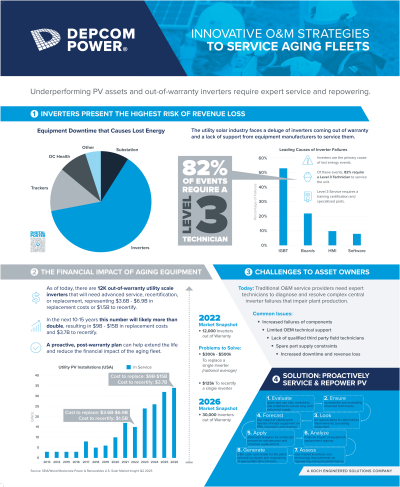Back

Finance and Asset Management
Innovative O&M Strategies to Repower Aging Fleets
Innovative O&M Strategies to Service Aging Fleets
Tuesday, September 12, 2023
4:30 PM - 5:30 PM PDT
Location: Poster Area, Booth #11024, Level 1, Venetian Expo Hall


Ananda Hartzell
VP of Business Development, Repowering Services
DEPCOM Power, Inc.
Scottsdale, Arizona, United States
Poster Presenter(s)
The utility solar industry faces a deluge of inverters coming out of warranty and a lack of support from equipment manufacturers (OEMs) to service them. Traditional O&M providers typically address these challenges within the scope of on-going service contracts. However, there is an industry shortage of dedicated expert technicians to diagnose and resolve the complex central inverter failures that impair plant production.
To meet this growing challenge, proactive asset owners are rethinking their O&M strategy, working with repowering experts to balance the capital expenses of inverter repowering with the revenue gains achieved with higher performing equipment and improved plant uptime.
Problem: DEPCOM Power’s analysis estimates that 12,000 inverters in the US will come out of warranty by 2023. With an average cost of $300k-$500k to replace a failed inverter, or approximately $125K to recertify, the industry is looking at potentially $3.6B-$6.9B to replace all units or approximately $1.5B to recertify these units as of 2023.
The lack of OEM presence results in the following difficulties for asset owners and operators with aging plants:
• Increased failures of critical parts and power stacks
• Limited OEM technical support
• Lack of qualified field service technicians (level 2 and 3 technicians)
• Lack of spare parts
• Downtime and lost revenue
Solution: Within the context of OEMs exiting the industry, asset owners with aging and out of warranty fleets have an opportunity to shift their O&M strategy to a long-term, proactive lifecycle planning.
Proactively repowering fleets requires high capital costs. Just replacing one failed inverter can be 1.5 times the cost of a newly installed unit. However, repairing legacy systems with lower DC voltages is also costly and requires specialized skill and equipment. Asset owners without this level of support can face months of downtime and revenue loss.
To meet this growing challenge, proactive asset owners are rethinking their O&M strategy, working with repowering experts to balance the capital expenses of inverter repowering with the revenue gains achieved with higher performing equipment and improved plant uptime.
Problem: DEPCOM Power’s analysis estimates that 12,000 inverters in the US will come out of warranty by 2023. With an average cost of $300k-$500k to replace a failed inverter, or approximately $125K to recertify, the industry is looking at potentially $3.6B-$6.9B to replace all units or approximately $1.5B to recertify these units as of 2023.
The lack of OEM presence results in the following difficulties for asset owners and operators with aging plants:
• Increased failures of critical parts and power stacks
• Limited OEM technical support
• Lack of qualified field service technicians (level 2 and 3 technicians)
• Lack of spare parts
• Downtime and lost revenue
Solution: Within the context of OEMs exiting the industry, asset owners with aging and out of warranty fleets have an opportunity to shift their O&M strategy to a long-term, proactive lifecycle planning.
Proactively repowering fleets requires high capital costs. Just replacing one failed inverter can be 1.5 times the cost of a newly installed unit. However, repairing legacy systems with lower DC voltages is also costly and requires specialized skill and equipment. Asset owners without this level of support can face months of downtime and revenue loss.
